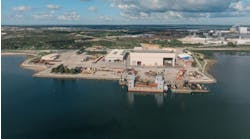Offshore staff
EDINBURGH, UK – The Convention on the Legal Status of the Caspian Sea is set to be signed later this year at the next summit of the heads of state of the five littoral countries (Azerbaijan, Iran, Kazakhstan, Russia, and Turkmenistan).
According to analyst Wood Mackenzie, there were positive statements late last year on determining the offshore median lines, especially from Russia’s Foreign Minister.
However, Iran appears to be sticking to its claimed territorial rights, undermining the likely scope of this year’s agreement. As a minimum, Iran wants an equal 20% share of the Caspian Sea, rather than the 11-13% provided by a median line approach.
Nevertheless, Wood Mackenzie’s view is that any progress is noteworthy, particularly if it creates a framework for future bilateral talks on disputes in the south Caspian.
The analyst also sees possible developments on stranded fields and suspended exploration projects in the Caspian region.
Moving forward is theBP-operated Shah Deniz Phase Two development, set to come onstream during the second half of this year. The $20-billion upstream project will be one of the largest global start-ups of the year, the analyst points out.
Azerbaijan and Europe are also close to realizing their ‘Southern Gas Corridor,’ with first gas due to enter Turkey in 2018 followed by deliveries to Italy, Greece, and Bulgaria from 2020 via theTrans Adriatic Pipeline.
Later this year, construction will also start on the Interconnector Greece-Bulgaria gas system.
Wood Mackenzie does not foresee any major final investment decisions on new projects during 2018, aside from the single-wellAbsheron early production scheme in Azerbaijan (effectively sanctioned in 2017).
Instead, the focus will be on preparing for approvals in 2019, including front-end engineering and design (FEED) and further optimization studies for new phases at theACG and Kashagan developments offshore Azerbaijan and Kazakhstan.
Kazakhstan’s new Subsoil Code and Tax Code should largely take effect this year, following approval in late 2017. It is designed to simplify and improve investment conditions for all natural resources, with reduced bureaucracy and faster approvals.
Changes to the Tax Code include an ‘alternative subsoil tax’ for new offshore and deep onshore. At qualifying fields, operators can opt for this arrangement to replace Mineral Extraction Tax, Rent Tax on Export, and Excess Profit Tax. The new tax will be levied on profit, with rates based on the prevailing oil price.
These represent the deepest reforms to the country’s subsoil regulations since 2009, Wood Mackenzie said, and although attracting new investment is the main issue, there should also be benefits for existing concession operators.
This could lead to IOCs re-evaluating the Kazakh offshore, the analyst claimed, following Eni’s recent entry into theoffshore Isatai block. Eni, ExxonMobil, and Shell have also expressed interest in partnering NC KazMunaiGas at the Abai block.
02/09/2018


